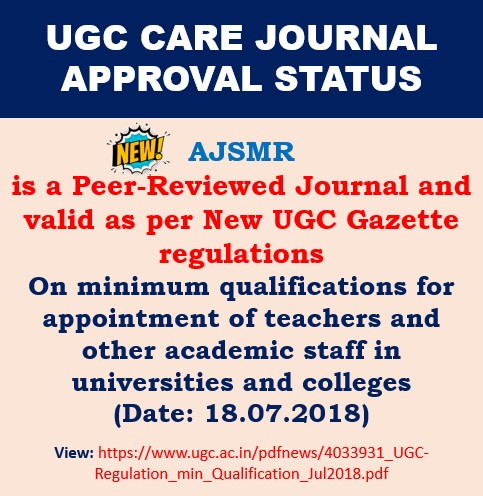Original Research Article I Volume 3 I Issue 3 I 2017
Evaluation of Antibacterial activity of fruit and root extracts of Withania somnifera against Human pathogenic bacteria
Kadudula Prasuna and Yalavarthy Prameela Devi
The American Journal of Science and Medical Research; 3(3); 12-15
DOI:http://dx.doi.org/10.17812/ajsmr3303
Abstract:
Withania somnifera, also known as ashwagandha, is an important herb in ayurvedic and indigenous medical systems. The present study was designed to evaluate the antibacterial activities of an 80% aqueous methanolic extract of W. somnifera roots and fruits. Antibacterial activities were measured using the agar well diffusion method and MIC values were determined by microdilution method and five pathogenic Gram-negative bacteria: Escherichia coli, Salmonella typhi, Citrobacter freundii, Pseudomonas aeruginosa and Klebsiella pneumoniae. The root extracts displayed the highest activity against S. typhi (32.00 ± 0.56 mm zone of inhibition), whereas the lowest activity was against K. pneumoniae (19.00 ± 1.56 mm zone of inhibition). The lowest minimum inhibitory concentration value was 6.25 mg/ml, which was against S. typhi, followed by 12.5 mg/ml against E. coli. It will be beneficial to investigate the active compounds present in W. somnifera so that its roots can be used to increase the armamentarium of antimicrobial agents and so that other possible therapeutic uses of the plant can be explored.
Keywords:
Antibacterial activity, Withania somnifera, methanol, MIC, agar well diffusion method,
References:
[1]. Acharyya S, Patra A, Bag PK: Evaluation of the antimicrobial activity of some medicinal plants against enteric bacteria with particular reference to multi-drug resistant Vibrio cholerae. Trop J Pharmaceut Res 2009, 8(3):231–237.
[2]. al-Hindawi MK, al-Khafaji SH, Abdul-Nabi MH. Anti-granuloma activity of Iraqi Withania somnifera. J Ethnopharmacol.1992;37(2):113–6.
[3]. Atlas, Ronald M: Micro-organisms in our World. St. Louis, Missouri: Mosby-Year Book, Inc; 1995:765 blz. ISBN 0 8016 7804 8.
[4]. Bhattacharya SK, Satyan KS, Ghosal S. Antioxidant activity of glycowithanolides from Withania somnifera. Indian J Exp Biol.1997;35(3):236–9.
[5]. Buchanan R. A weaver's garden.Loveland Colorado: Interweave Press; 1987.
[6]. Jain P, Varshney R: Antimicrobial activity of aqueous and methanolic extracts of Withania somnifera (Ashwagandha). J Chem Pharmaceut Res 2011, 3(3):260–263.
[7]. Kahkonen MP, Hopia AI, Vuorela HJ PRJ, Pihlaja K, Kujala TS, Heinonen M: Antioxidant Activity of Plant Extracts Containing Phenolic Compounds. J Agric Food Chem 1999, 47:3954–3962.
[8]. Kulkarni SK, Ninan I. Inhibition of morphine tolerance and dependence by Withania somnifera in mice. J Ethnopharmacol. 1997;57(3):213–7.
[9]. Schliebs R, Liebmann A, Bhattacharya SK, Kumar A, Ghosal S, Bigl V. Systemic administration of defined extracts from Withania somnifera (Indian Ginseng) and Shilajit differentially affects cholinergic but not glutamatergic and GABAergic markers in rat brain. Neurochem Int. 1997;30(2):181–90.
[10]. Vattem D, Lin YT, Labbe RG, Shetty K: Antimicrobial activity against select food-borne pathogens by phenolic antioxidants enriched in cranberry pomace by solid-state bioprocessing using food grade fungus Rhizopus oligosporus. Process Biochem 2004, 39:1939–1946...
Article Dates:
Received: 30 May 2017; Accepted: 21 July 2017; Published: 29 July 2017
How To Cite:
Pranavi Sreeramoju and Estari Mamidala (2017). An Ethnobotanical Survey of Antidiabetic plants used by tribes of Warangal District, Telangana State. The Ame J Sci & Med Res, 3(3):8-11. doi:10.17812/ajsmr3302.



